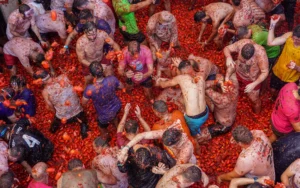Every culture has its own unique traditions, some of which might seem unusual or even bizarre to outsiders. These traditions often have deep-rooted historical, religious, or social significance. Here are some of the most unusual cultural traditions from around the world that showcase the incredible diversity of human customs.
1. La Tomatina – Spain

Every year, the small town of Buñol in Spain hosts La Tomatina, the world’s largest food fight. On the last Wednesday of August, thousands of participants gather to throw overripe tomatoes at each other, covering the streets in a sea of red. The origins of this tradition are unclear, but it has become a popular tourist attraction, drawing visitors from around the globe.
2. Cheese Rolling Festival – England
The Cheese Rolling Festival in Gloucestershire, England, is a unique and somewhat dangerous event. Participants chase a round of Double Gloucester cheese down a steep hill, often tumbling head over heels in the process. The first person to reach the bottom and cross the finish line wins the cheese. This quirky tradition dates back to the early 19th century and continues to attract thrill-seekers every year.
3. Thaipusam – Malaysia and Singapore
Thaipusam is a Hindu festival celebrated mainly by the Tamil community in Malaysia and Singapore. Devotees undertake a pilgrimage to a temple while carrying kavadi – ornate structures that can be attached to the body with hooks and skewers. The practice involves piercing the skin, tongue, and cheeks in acts of devotion and penance. Despite the physical pain, devotees believe it brings them spiritual merit and blessings.
4. Kanamara Matsuri – Japan
The Kanamara Matsuri, also known as the Festival of the Steel Phallus, is celebrated annually in Kawasaki, Japan. The festival is dedicated to fertility and protection against sexually transmitted infections. Participants carry giant phallus-shaped mikoshi (portable shrines) through the streets, and various phallus-themed souvenirs are sold. The origins of this festival are rooted in local folklore and Shinto beliefs.
5. Day of the Dead – Mexico

Día de los Muertos (Day of the Dead) is a Mexican tradition that honors deceased loved ones. Celebrated from October 31 to November 2, families create altars with photos, candles, and offerings like food and flowers. The vibrant celebrations include parades, music, and intricate sugar skull decorations. It’s a time for joyous remembrance rather than mourning, emphasizing the belief that death is a natural part of life.
6. Famadihana – Madagascar
In Madagascar, the Famadihana or “Turning of the Bones” ceremony involves exhuming the bodies of deceased relatives, rewrapping them in fresh cloth, and celebrating their memory with music and dance. This ritual is performed every five to seven years and is a way for families to honor their ancestors, seek their blessings, and maintain a connection with them.
7. Maasai Jumping Dance – Kenya and Tanzania
The Adumu, or Maasai jumping dance, is a traditional ceremony performed by the Maasai people of Kenya and Tanzania. Young warriors, known as morans, gather in a circle and take turns leaping into the air. The higher they jump, the more respect they earn. This dance is part of the Maasai’s coming-of-age rituals and is a demonstration of strength and endurance.
8. Up Helly Aa – Scotland
Up Helly Aa is a fire festival celebrated in Scotland’s Shetland Islands, commemorating the region’s Viking heritage. Held in January, the festival features participants dressed as Vikings who parade through the streets with flaming torches. The climax of the event is the burning of a replica Viking longship, creating a dramatic and fiery spectacle.
9. El Colacho – Spain
In the small Spanish village of Castrillo de Murcia, the annual El Colacho festival involves a peculiar ritual known as “baby jumping.” Men dressed as devils leap over rows of infants lying on mattresses in the street. This tradition, which dates back to the 17th century, is believed to cleanse the babies of original sin and protect them from evil spirits.
10. Mud Festival – South Korea

The Boryeong Mud Festival in South Korea is a relatively new tradition, starting in 1998 to promote the mineral-rich mud of Boryeong. The festival, held every July, includes mud wrestling, mud sliding, and various other mud-themed activities. Participants believe that the mud has therapeutic properties, and the event has become a popular summer attraction for both locals and tourists.
Conclusion
These unusual cultural traditions highlight the incredible diversity and creativity of human customs. Each tradition, no matter how strange it may seem, has deep cultural significance and reflects the values, beliefs, and history of the community that practices it. By learning about and respecting these traditions, we can gain a greater appreciation for the richness of human culture and the unique ways people around the world celebrate life

